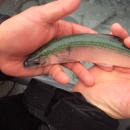We are helping states locate and assess lake sturgeon populations, which were nearly eliminated from the Great Lakes basin in the early 1900’s due to over fishing and habitat degradation. Biologists with the Northeast Fishery Center and the Lower Great Lake Fish and Wildlife Conservation Office are conducting multi-faceted research on lake sturgeon in Lake Erie, the Niagara River, and Lake Ontario. We are implanting lake sturgeon with acoustic tags and pop-off archival satellite tags to determine movement and habitat use of lake sturgeon. We are assessing age structure using sections of pectoral spines; we are conducting mark-recapture studies to help estimate population size; we also are mapping habitat using side-scan sonar; conducting genetic analysis to determine how populations are related; and coordinating Lake Erie-wide assessment of the distribution of juvenile lake sturgeon. Results from these studies will better define the life history and habitat needs of sturgeon in the lower Great Lakes, and will inform management decisions for the conservation of this species. Data gathered thus far on lake sturgeon abundance, migration patterns, and spawning success in the Niagara River, Lake Ontario, and Lake Erie is guiding the New York Department of Environmental Conservation’s decisions on listing and habitat protection.
Fisheries management, Monitoring



